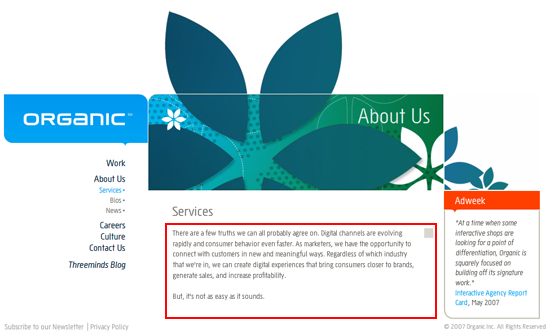One of the trickiest challenges I have is defining what kind of services firm Adaptive Path is. For the sake of this post, let’s say AP is a firm that designs for interactive media — websites, software, mobile phones, devices, and kiosks.
Design for interactive media is a hot space right now, because of all the money flooding in online advertising. For example, Schematic was acquired last September by WPP, a massive holding company of communications services firms. Unsubstantiated word is that Schematic went for 6 times earnings, which is astounding, considering services firms typically get at best 3x. (12 years ago, I worked with Schematic CEO Trevor Kaufman when he lead up the website at Voyager. What a long strange trip!)
The thing is, AP is not an interactive design firm like Schematic, Organic, Razorfish, Digitas, etc. For one thing, we’re much smaller (though we feel big to ourselves, at 32 employees, we’re about a fifth to a tenth of the size of these others firms). But, and this is the crux of this post, we pretty much don’t touch marketing, and never advertising.
(In 2005, we decided to never do “just marketing” work again. This is because, although lucrative, as attested to by the growth of these other agencies, we realized that the people we brought on pretty much loathed marketing communications. We don’t want to work on the stuff that talks about the thing — we want to work on the thing itself.)
See, all these other companies are essentially interactive agencies, with a heavy emphasis on advertising and media planning. And currently, because of the movement of advertising dollars online, these companies are doing remarkably well.
Adaptive Path is more like an interaction design analog of an IDEO or Frog — where they began with industrial design, we began with interaction design, and we’ve all evolved into product strategy and design firms. In 2007, we found ourselves going up against IDEO and Frog far more than interactive agencies.
Now, back to the title of this post. I suspect that “the market” finds it a lot easier to find value in interactive marketing agencies more than in interactive product consultancies. And what I’m trying to figure out is why this is the case. Products (and I’m using that term generically, to include services and all manner of offerings) are what provides value. They are what get people to spend money, to engage in a service. They *create* value. But it’s marketing design, particularly advertising, which is what has been lucrative — think of the big ad firms going back 40, 50, 60 years. There are no big product design firms more than 30 years old, and there still isn’t anywhere near the kind of money in product design as in marketing.
(As I write this, I realize that the rise of the product design firm over the last 30 years, and the two companies I most associate with that rise (IDEO and Frog) are pretty much the result of the increasing complexity of product design thanks to computerization.)
I don’t have a close to this thought. I’ve just been mulling over why product design firms, which create value, don’t seem to be perceived as valuable as marketing design firms.

